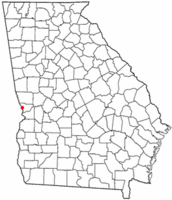Bibb City, Georgia facts for kids
Quick facts for kids
Bibb City, Georgia
|
|
|---|---|

Location of Bibb City, Georgia
|
|
| Country | United States |
| State | Georgia |
| County | Muscogee |
| Area | |
| • Total | 0.2 sq mi (0.4 km2) |
| • Land | 0.2 sq mi (0.4 km2) |
| • Water | 0.0 sq mi (0.0 km2) |
| Elevation | 338 ft (103 m) |
| Population
(2007)
|
|
| • Total | 648 |
| • Density | 3,064.9/sq mi (1,183.4/km2) |
| Time zone | UTC-5 (Eastern (EST)) |
| • Summer (DST) | UTC-4 (EDT) |
| FIPS code | 13-07864 |
| GNIS feature ID | 0331158 |
|
Bibb City Historic District
|
|
| Lua error in Module:Location_map at line 420: attempt to index field 'wikibase' (a nil value). | |
| Location | Roughly bounded by Chattahoochee River, Woodland Cir., 2nd Ave. and 35th St., Bibb City, Georgia |
|---|---|
| Area | 48 acres (19 ha) |
| Built | 1900 |
| Architect | Blair, Algernon; et al. |
| Architectural style | Classical Revival, Bungalow/craftsman |
| NRHP reference No. | 10000037 |
| Added to NRHP | February 24, 2010 |
Bibb City was once a small town in west-central Georgia, United States. It was special because it was a "company town." This means it was built and mostly run by a large factory, the Bibb Manufacturing Company. The town was located in Muscogee County.
In its last official count in 2000, Bibb City had 510 people. The entire area, including the historic factory and the homes built for workers, is now part of the larger city of Columbus. Today, it is recognized for its history as the Bibb City Historic District and is listed on the National Register of Historic Places.
Contents
A Town Built Around a Mill
Bibb City became an official city in 1909. It was created to serve the Bibb Manufacturing Company, which had a big textile mill there. A textile mill is a factory that makes fabric and cloth.
The mill was the heart of the town for many years. However, the mill closed down in 1998. After the mill closed, Bibb City faced a big problem. It didn't have enough money to keep running as a separate city. So, on December 7, 2000, the city officially gave up its city status. Bibb City then became a part of Columbus.
In 2006, Bibb City was suggested to become a historic district. This means its important buildings and history would be protected. On February 14, 2010, this idea was approved. The area officially became the Bibb City Historic District.
Where Was Bibb City?
Bibb City was located at 32°30′5″N 84°59′31″W / 32.50139°N 84.99194°W. It was a very small town. Its total area was only about 0.2 square miles (0.4 square kilometers), and all of it was land.
People of Bibb City
The number of people living in Bibb City changed a lot over the years. Here's how its population grew and then shrank:
- 1910: 463 people
- 1920: 1,090 people
- 1930: 1,707 people (its highest population)
- 1940: 1,631 people
- 1950: 1,452 people
- 1960: 1,213 people
- 1970: 812 people
- 1980: 667 people
- 1990: 597 people
- 2000: 510 people (its last official count)
In 2000, there were 510 people living in Bibb City. About 24% of the people were under 18 years old. The average age was 36 years.
The Big Mill's Story
The most important building in Bibb City was the Bibb Manufacturing Company's Columbus Mill. This mill was huge, about 750,000 square feet (70,000 square meters).
In the 1940s, the mill was at its busiest. It employed 2,500 workers and was the largest cotton mill in the United States. Most of the textile workers at that time were white.
The mill closed in 1998 but remained standing for a few years. Sadly, on October 30, 2008, a massive fire destroyed the entire Columbus Mill. The cause of the fire was never found.
Weather in Bibb City
The weather in the Bibb City area is usually warm. It gets rain throughout the year. This type of weather is called a humid subtropical climate.
Here's a quick look at the average temperatures and rainfall:
- Warmest Month: July, with average high temperatures around 91°F (33°C).
- Coolest Month: January, with average low temperatures around 35°F (2°C).
- Rainfall: The area gets about 49.6 inches (126 cm) of rain each year. March and July are usually the wettest months.
| Climate data for Bibb City, Georgia | |||||||||||||
|---|---|---|---|---|---|---|---|---|---|---|---|---|---|
| Month | Jan | Feb | Mar | Apr | May | Jun | Jul | Aug | Sep | Oct | Nov | Dec | Year |
| Mean daily maximum °C (°F) | 14 (57) |
16 (60) |
20 (68) |
25 (77) |
28 (82) |
32 (89) |
33 (91) |
32 (89) |
30 (86) |
25 (77) |
19 (66) |
15 (59) |
24 (75) |
| Mean daily minimum °C (°F) | 2 (35) |
3 (37) |
7 (44) |
10 (50) |
15 (59) |
20 (68) |
22 (71) |
21 (69) |
18 (64) |
12 (53) |
6 (42) |
3 (37) |
11 (51) |
| Average precipitation mm (inches) | 110 (4.3) |
120 (4.6) |
140 (5.7) |
110 (4.3) |
100 (4) |
97 (3.8) |
140 (5.5) |
99 (3.9) |
81 (3.2) |
51 (2) |
91 (3.6) |
120 (4.7) |
1,260 (49.6) |
| Source: Weatherbase | |||||||||||||
Education in Bibb City
Children living in Bibb City attended schools that were part of the Muscogee County School District.

